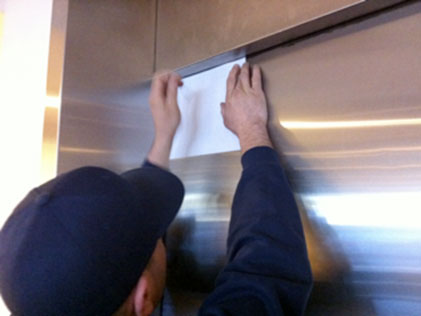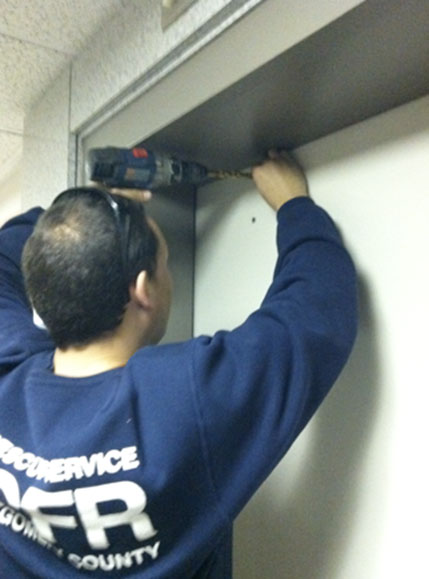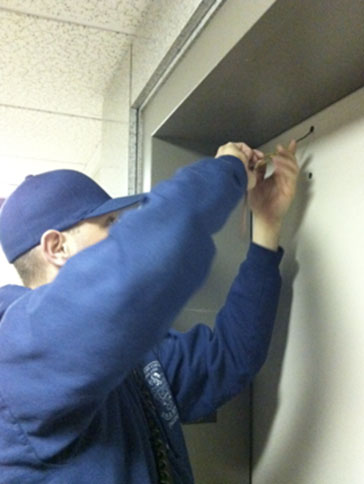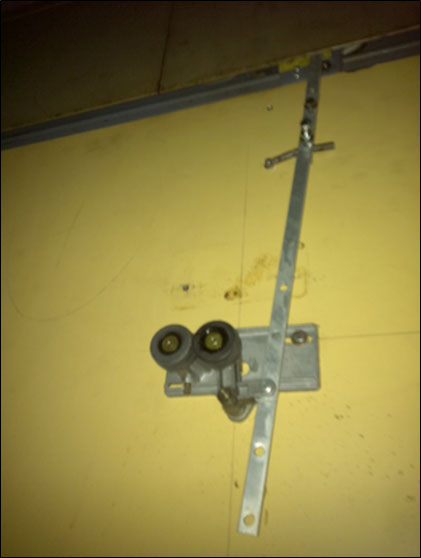By Sam Villani III and Frank Ricci
With the passage of the Americans with Disabilities Act, elevators can be found in almost all of our communities. Extracting occupants from a stalled elevator car make for a complicated rescue. Finding ways to think outside the box is one of the keys to minimizing the risk.
Repair Technicians
All firefighters who are called on to respond to these calls should be trained in elevator rescue. The fire department should also have a protocol for notifying a certified elevator technician on dispatch. If they arrive before the occupant is removed, these technicians will work under the direction of the incident commander.
The technician may be able to provide valuable insight or be able to safely restart the car. It is important to understand that once 911 is called, the fire department bears the responsibility to mitigate the incident.
Firefighters should not become overly reliant on repair technicians, however. This could cause complacency that might increase the hazard to the public and firefighters alike. We have all experienced times when no technician is available or they are delayed in responding to the scene.
Having a technician respond is the equivalent of having a manufacturers’ representative on scene at a hazmat incident. They should always work within the command structure and always have a firefighter with a radio assigned to them.
When firefighters arrive, they should identify the:
- Type and construction of the elevator
- Location of power room
- Number of trapped occupants
- Position of stalled cars
- Location of drop keyholes
Firefighters should always station a firefighter at the power room to shut off and control the power. If a firefighter cannot remain at the elevator room, a lock-out/ tag-out system can be used, but it must be tamper-proof and be clearly marked as being secured by working emergency services. Firefighters should also ensure they reassure the occupants that they are going to be all right.
Drop Keyholes
Drop key and manual-access holes are typically found on the hoistway doors at the bottom and top floors. In some cases they can be found intermittently on every other floor. This access point allows us to use a drop key and manually access the hoistway.
The safest option is to remove the occupants trapped through the elevator door they entered.
As the infrastructure in our older buildings continues to deteriorate and elevators age, firefighters will likely encounter more elevator rescues. One common situation we face is an occupant trapped behind the hoistway door without a hole for a drop key.
With no drop keyhole, our options become riskier. The most dangerous of these operations is poling (using an elevator pole to open a hoistway door from an accessible hoistway point.) This operation is further complicated if you are unable to pole across because of a single shaft.
This situation requires emergency services to use the elevator pole from above or below to activate the hoistway door release mechanism. This is a high-risk operation: our personnel end up hanging over the plane of the hoistway in a precarious manner, trying to manipulate the long, gangly pole into position. Rockville (MD) firefighters created a better way.
Creating Your Own Keyhole
Creating new, low-risk options is imperative for safe, efficient, and effective operations. While attending Montgomery College, we were taught that “circumstances dictate actions” and that thinking outside the box to accomplish the incident’s operational objectives will always serve you well.
Rockville’s Tower 3 recently illustrated an example of this type of firefighter ingenuity. Their crew experienced an “out-of-the-box” moment while making an elevator rescue of several occupants in a stalled car. In this incident, firefighters were faced with a single shaft, eliminating the option of poling across.
Instead of poling up three floors to get to the stalled car, the tower’s driver decided to make an imprint of the drop keyhole’s location on the lobby door. Using this template, firefighters created an impromptu hole on the hoistway door closest to the stalled car. This action allowed for a safer extraction. Truck companies in Rockville carry cordless drill sets with high-speed steel drill bits, which made the job easy (photo 1). Below is an illustration of how Tower 3’s crew accomplished this objective.

(1) The tower driver marks the drop keyhole by using piece of paper, measuring the distance of the hole from the elevator wall, and marking it on the paper with a pen.

(2) A member of Tower 3 drills a keyhole after marking its location with the paper template.

(3)Tower 3’s driver using an elevator key to manipulate the hoistway door latch mechanism.

(4) Notice at the top center of this photo, the key is catching the hoistway door mechanism, allowing it to release and the door to open. Note that some doors will require slight pressure in the direction that the door opens to release the latch.
Hopefully this method will work for you the next time you’re presented with a stalled car behind a hoistway door that is not keyed. If you’re hesitant to drill a hole in door that does not belong to you, consider the risk of the alternative.
This tactic is a valuable tool for the box. The operation is no different than going through the lock at a pot-on-the stove call. Remember, once 911 is activated, it is your responsibility to ensure that the extraction or rescue is effected the safest way possible.
Special thanks to the crew of Rockville Tower 3 (Montgomery County, Maryland), Master Firefighter Noel Hull, and Firefighter Nicholas Garner
 Sam Villani III is a Lieutenant with the Montgomery County (MD) Fire and Rescue Service, assigned to day work at Rockville Company 3, presently on recruit-training detail at the Public Safety Training Academy. Sam is the son and grandson of firefighters in the Ocean City (MD) Volunteer Fire Company, where he still is an honorary member. Sam volunteered in fire departments in Prince George’s and Montgomery Counties while attending college. He holds an associate’s degree in public fire protection from Montgomery College and a bachelor’s degree from the University of Maryland in sociology. He was appointed as a career firefighter in Montgomery County in 1999. He teaches at the Montgomery County Public Safety Training Academy and with Capitol Fire Training, and is a Maryland-certified level II instructor. In his downtime, Sam works with the nonprofit he co-founded, the Don’t Panic Foundation, a 501(c)(3) nonprofit that helps critically ill and injured public safety professionals.
Sam Villani III is a Lieutenant with the Montgomery County (MD) Fire and Rescue Service, assigned to day work at Rockville Company 3, presently on recruit-training detail at the Public Safety Training Academy. Sam is the son and grandson of firefighters in the Ocean City (MD) Volunteer Fire Company, where he still is an honorary member. Sam volunteered in fire departments in Prince George’s and Montgomery Counties while attending college. He holds an associate’s degree in public fire protection from Montgomery College and a bachelor’s degree from the University of Maryland in sociology. He was appointed as a career firefighter in Montgomery County in 1999. He teaches at the Montgomery County Public Safety Training Academy and with Capitol Fire Training, and is a Maryland-certified level II instructor. In his downtime, Sam works with the nonprofit he co-founded, the Don’t Panic Foundation, a 501(c)(3) nonprofit that helps critically ill and injured public safety professionals.


